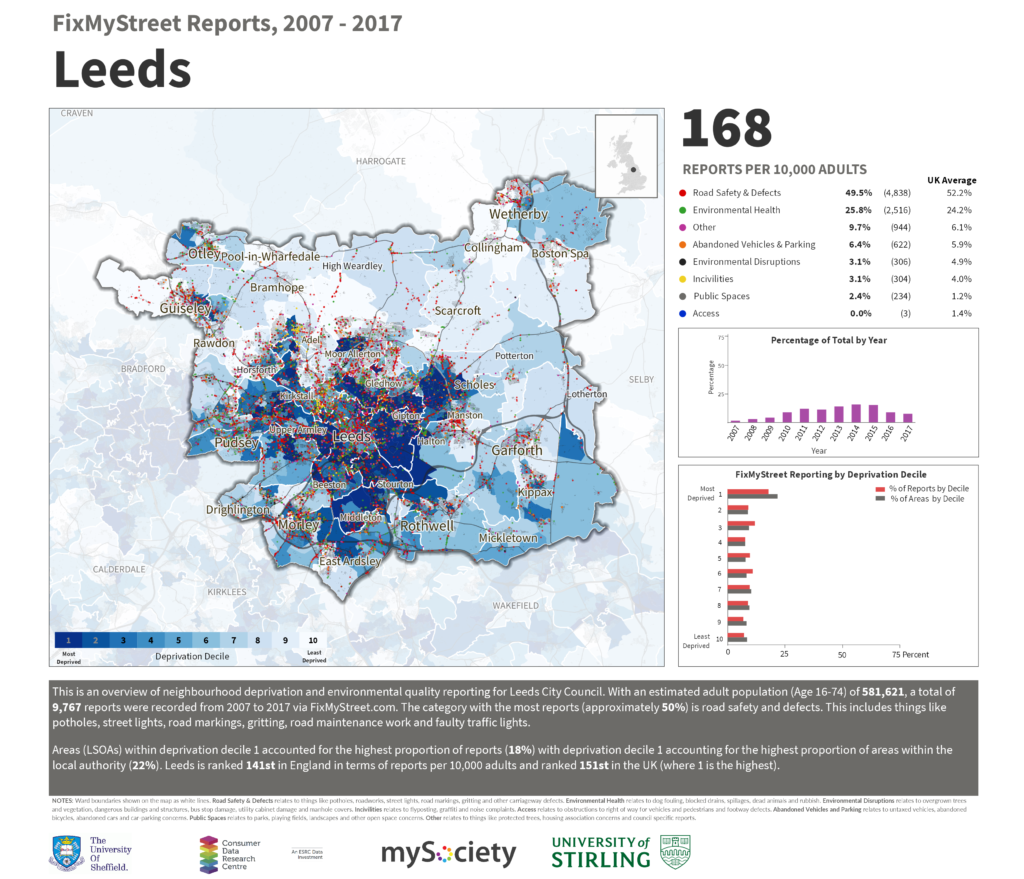
FixMyStreet: Micro-geographies of civic engagement and neighbourhood environmental quality
Professor Alasdair Rae, University of Sheffield
This project was funded through the Consumer Data Research Centre Innovation Fund, backed by the ESRC. Developed to drive innovative social science research across a broad range of disciplines and research areas.
Introduction
Providing local environmental services, such as repairing streets and collecting rubbish are the most basic and necessary tasks of local government. Such services are commonly addressed through citizen-initiated reporting.
Research highlights the links between a good-quality local environment and good health and wellbeing of residents, with increased social capital and empowerment felt by residents.
Evidence suggests that residents in more affluent areas are more likely to report a problem. By relying on citizens to report problems more prosperous neighbourhoods could receive a higher level of service from their local council.
The project assesses where and what kind of requests for local environmental services come from.
Project aims
Using the data provided by FixMyStreet (c.1m records) to explore local neighbourhood conditions across the UK in relation to income, deprivation, household moves, transport, health and internet penetration.

Explaining the science
This project makes use of a large street quality reporting dataset (from FixMyStreet) over an eleven year period in combination with existing CDRC data assets, to explore micro-geographies of civic engagement and neighbourhood environmental quality.
For the analysis to be useful, and make sense at a local level, the project produced a high-resolution map and data poster for every local authority in the UK. These show the location of reports, what category they fall into, how they compared to other areas. Comparisons were done with the number of reports in an area, to their deprivation profile.
391 graphics were produced – one for each UK local authority (except county councils as these overlap with other local authorities). Each graphic covers the full period from 2007 to 2017, shows the number of reports per 10,000 adults and a breakdown of reports by type.
You can view the maps online here.
What the analysis of FixMyStreet data actually shows:
Detailed visualisations of where more than 1 million neighbourhood environmental quality reports have been submitted in the UK over more than a decade.
Improved understanding of what local residents find important in relation to neighbourhood quality. By looking at the break-down of reports by type across different areas we get an insight into what matters to people. This predominantly seems to be things like potholes, fly-tipping and dog fouling.
How the uptake of the technology itself (i.e. the FixMyStreet website and app) has developed in different parts of the country.
How reporting rates vary between different types of neighbourhood. This study used neighbourhood deprivation levels as a proxy for neighbourhood type, but there are other ways. Nonetheless, some important differences in reporting levels in relation to deprivation, both at the national and local level were observed.
Applications
The results will be interesting and useful for local people, councils and anyone with an interest in neighbourhood environmental quality. Interested parties can also download the data which mySociety have made available as part of this project, and conduct further analyses.
These data could be used by councils to understand whether service provision is equitable and neighbourhoods are assessed on the need rather than where the residents are most engaged. From what is know about neighbourhood environmental quality in the nation’s most deprived areas, this analysis of FixMyStreet data would suggest that there is significant under-reporting of issues in those neighbourhoods which fall into the most deprived decile.
“Working with partners at the University of Stirling and University of Sheffield has been a great way to unleash the power of our data and share the findings with the world. Without the ESRC’s funding this would not have been possible, so it’s a win all-round.” Alex Parsons, mySociety
